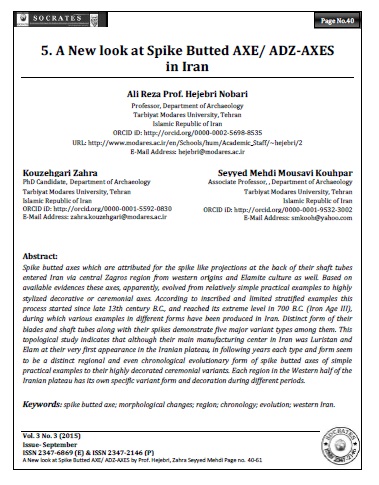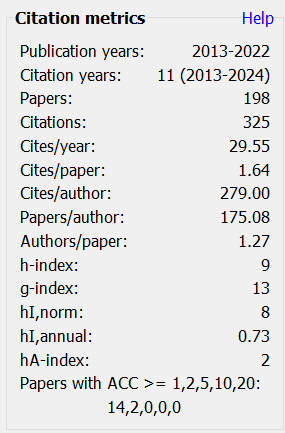A New look at Spike Butted AXE/ ADZ-AXES in Iran
Keywords:
spike butted axe, morphological changes, region, chronology, evolution, western IranAbstract
Spike butted axes which are attributed for the spike like projections at the back of their shaft tubes entered Iran via central Zagros region from western origins and Elamite culture as well. Based on available evidences these axes, apparently, evolved from relatively simple practical examples to highly stylized decorative or ceremonial axes. According to inscribed and limited stratified examples this process started since late 13th century B.C., and reached its extreme level in 700 B.C. (Iron Age III), during which various examples in different forms have been produced in Iran. Distinct form of their blades and shaft tubes along with their spikes demonstrate five major variant types among them. This topological study indicates that although their main manufacturing center in Iran was Luristan and Elam at their very first appearance in the Iranian plateau, in following years each type and form seem to be a distinct regional and even chronological evolutionary form of spike butted axes of simple practical examples to their highly decorated ceremonial variants. Each region in the Western half of the Iranian plateau has its own specific variant form and decoration during different periods.
Downloads
Metrics
References
Calmeyer, P. (1969). DatierbareBronzenausLuristan und Kirmanshah, Berlin.
Curtis, J. &Kruszynski, M. (2000). Ancient Caucasian and Related Material in the British Museum, British Museum Press. London.
Curtis, J. (1990). Ancient Persia, London: British Museum Press.
Dossin, G. (1962). Bronzes Inscrits du Luristan de la Collection Foroughi, Iranica Antiqua 2, fasc. 2. 149-179.
Gadd, C., J. (1931). More Luristan Bronzes, The British Museum Quarterly 6, No. 3, 79-80.
Ghirshman, R. (1953). Travaux de la mission archéologique en Susiane en hiver 1952-1953, Syria, T. 30,Fasc. 3/4, 222-233.
Ghirshman, R. (1960). UneHache Votive au Nom du Roi Elamite ŠilhakAnšušinak (1165- 1151),Iraq, 21, 210- 211
Ghirshman, R. (1968) TchogaZanbil (Dur- Untash) Vol. II, Temenos, Temples, Palasis, Tombes, Mémoires Délégation Archéologique en Iran, Vol. XL, Paris.
Godard, A. (1931). Les Bronzes de Luristan, Paris.
Godard, A. (1962).L’art de l’Iran, Paris.
Haerinck, E. &Overlaet, B. (1999). Djub-iGauhar and Gul KhananMurdah, Iron Age III sites in the Aivan plain, Luristan Excavation Documents III, ActaIranica 36, 3e série, Leuven.
Haerinck, E. &Overlaet, B. (2004a). The Iron Age III Graveyard at War Kabud, Pusht-iKuh, Luristan,”Luristan excavation documents 5, ActaIranica 42, Leuven.
Haerinck, E. &Overlaet, B. &Mohammadi, J., Z. (2004b). Finds from Khatunban B- Badavar Valley, (Luristan) in the Iran Bastan Museum, Iranica Antiqua 39, 105- 168.
Maxwell-Hyslop, R. (1949). Western Asiatic Shaft-Hole Axes, Iraq 11, No. 1, 90-129.
Moorey, P.R.S. (1991). The Decorated Ironwork of the Early Iron Age Attributed to Luristan in Western Iran, Iran 29, 1-12.
Moorey, P. R. S. (1971: Jan). Towards a Chronology for the "L?rist?n Bronzes", Iran: Journal of the British Institute of Persian Studies, 9, 113-129.
Moorey, P.R.S. (1971). A Catalogue of the Persian Bronzes in the Ashmoleam Museum, Oxford: Clarendon Press.
Moshtagh, K.M. (2006). Arms and Armor from Iran: The Bronze Age to the End of the Qajar Period,LegatVerlag.
Muscarella, O.W. (1989). Warfare at Hasanlu in Late 9th Century B.C., Expediotion, 31, No. 2-3, 24-36.
Muscarella, O., W. (1988a). The Background to the Luristan Bronzes, in J. Curtis, ed., BronzeworkingCentres of Western Asia 1000-539 B.C., London, 177-92.
Muscarella, O., W. (1988b) Bronze and Iron: Ancient Near Eastern Artifacts in Metropolitan Museum of Art, New York. Met. Museum Press.
Negahban, E.O. (1977). A Guide to Haft Tepe Excavation and Museum, General Department of Museum, Philadelphia.
Negahban, E. O. (1995). Weapons from Marlik, Dietrich Reimer, Berlin.
Overlaet, B. (2005). The Chronology of the Iron Age in Posht-i- Kuh, Luristan, Iranica Antiqua XL, 1-33.
Overlaet, B. (2003). The Early Iron Age in Pusht-iKuh, Luristan, Luristanexcavation documents 4", ActaIranica, 40, Leuven.
Pope, A. U. (1941). A Survey of Persian Art, Vol. IV, London.
Potratz, J. A. H. (1968). LuristanBronzen, Istanbul.
Schaeffer, C. F. A. (1948). Stratigraphie Comparee et Vhronologie de l'Asie Occidentale (IIIe et IIe Millénaires), London.
Schmidt, E. F. & M. N. van Loon & H. H. Curvers. (1989). The Holmes expeditions to Luristan, 2 vols. Chicago.
Talai’I. H. (2008). The Iron Age of Iran, Samt, Tehran. (in Persian)
Thrane, H. (1964). Archaeological Investigations in Western Luristan, preliminary report of the second Danish archaeological expedition to Iran, ActaArchaeologica 35, 153-69.
Vanden Berghe, L. (1968).Het ArcheologishOnderzoeknaar de BronscultuurvamLuristan, Brussels.
VandenBerghe, L. (1967). The Bronzes of the Shepherds and Horsemen of Luristan, ArchaeologiaVinant 1, 20- 63
Vanden Berghe, L. (1964). La Nécropole De Khurvin, Istanbul.
Zahlhaas, G. (2002). Luristan Antik Bromz Aus dum Iran, München.

Downloads
Published
How to Cite
Issue
Section
License
Revised Copyright/CC license that applies to all the articles published after 05-02-2017
Attribution-NonCommercial 4.0 International (CC BY-NC 4.0)

Copyright/CC license that applies to all the articles published before 05-02-2017
Attribution-Non Commercial-No Derivatives 4.0 International (CC BY-NC-ND 4.0)

Author(s) will retain all the right except commercial and re-publishing rights. In the case of re-publishing, they will have to obtain written permission from the journal. Additional licensing agreements (Creative Commons licenses) grants rights to readers to copy, distribute, display and perform the work as long as you give the original author(s) credit, they can not use the works for commercial purposes and are not allowed to alter, transform, or build upon the work. For any reuse or distribution, readers and users must make clear to others the license terms of this work. Any of these conditions can be waived if you get permission from the copyright holders. Nothing in this license impairs or restricts the authors’ rights. To view a copy of this license, visit http://creativecommons.org/licenses/by-nc-nd/4.0/ or send a letter to Creative Commons, 171 Second Street, Suite 300, San Francisco, California, 94105, USA.
Research Papers published in SOCRATES are licensed under an Attribution-NonCommercial-NoDerivatives 4.0 International (CC BY-NC-ND 4.0)












